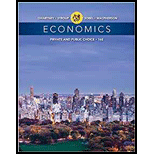
Economics: Private and Public Choice (MindTap Course List)
16th Edition
ISBN: 9781305506725
Author: James D. Gwartney, Richard L. Stroup, Russell S. Sobel, David A. Macpherson
Publisher: Cengage Learning
expand_more
expand_more
format_list_bulleted
Question
Chapter 22, Problem 16CQ
(a)
To determine
Filling of table with marginal cost,
(b)
To determine
Lowest
(c)
To determine
The output produced by firm A at the lowest price.
(d)
To determine
Lowest price at which firm A will produce.
(e)
To determine
The output produced by firm B at the lowest price.
(f)
To determine
Production of firm A when the market price is $20.
(g)
To determine
Production of firm B when the market price is $20.
(h)
To determine
Firm achieves higher profit or smaller loss in the case of fixing a $20 as price, when its fixed cost is $20.
(i)
To determine
Net
Expert Solution & Answer
Want to see the full answer?
Check out a sample textbook solution
Students have asked these similar questions
What bill are they currently sponsoring? Please provide the answer to the question using www.akleg.gov for Senate Bill 30?
Do they have any specified areas of interest( examples: oil/gas, education, subsistence). Please provide the answer to the question using www.akleg.gov for Senate Bill 30?
A brief synopsis of whether you believe they represent your interest, why or why not? Please provide the answer to this question by using www.akleg for senate bill 30 ?
Chapter 22 Solutions
Economics: Private and Public Choice (MindTap Course List)
Knowledge Booster
Similar questions
- What is their background (degree, career/job, community of origin, anything else you choose to include) Please provide the answers using www.akleg.gov for Senate Bill 30?arrow_forwardPlease provide the answer to these questions using informatioin from www.akleg.gov for Senate bill 30. What is their party affiliation?arrow_forwardPlease provide the answer to the question using information from www.akleg.gov for Senate Bill 30. How lonng have they been in public office?arrow_forward
- Please provide the answer to the following questions using www.akleg.gov website for Senate Bill 30. What District do they represent?arrow_forwardPlease provide the answer to this question using www.akleg.gov for Senate Bill 30? Do they hold any committe seats?arrow_forwardWhat impact does the North American Free Trade Agreement have on relations between countries in North America? NAFTA regulates and enforces protections for workers to ensure that they have safe working environments and fair wages. NAFTA eliminates tariffs and trade restrictions, facilitating export and import between countries in North America. NAFTA sets up regulations limiting industrial pollution in all three countries, ensuring the costs of manufacturing are similar in each country. NAFTA eliminates trade restrictions on products from embargoed countries.arrow_forward
- Which of the following is included in the GDP_________? Group of answer choices The two answers describe components of the GDP. The federal government expenditure on welfare payments. Households goods and services produced at home. Neither of the two answers describe components of the GDP.arrow_forwardWhat are two examples of where historical cost is used within the financial statements. State both the account name and the amount for each account selected. What was the amount of revenue that Airbnb reported for 2024? Did the revenue grow over the prior year of 2023? What was the dollar and the percentage increase or decrease?arrow_forwardWhat was the amount of revenue that Airbnb reported for 2024? Did the revenue grow over the prior year of 2023? What was the dollar and the percentage increase or decrease? What was the amount of net income or net loss that Airbnb reported for the year of 2024? Did the net income increase or decrease versus the prior year of 2023? What was the dollar and the percentage increase or decrease?arrow_forward
- Who are the Airbnb's independent auditors and what is the role of these auditors? What opinion do the Airbnb independent auditors express regarding the financial statements and what does this opinion mean to an investor?arrow_forwardDoes Airbnb's fiscal year-end coincide with a calendar year-end? What products and/or services does Airbnb sell? Please be detailed. What major industry does Airbnb operate in? name at least two competitors. What are two risks identified by Airbnb management? Describe these risks.arrow_forwardSolve please and thanks!arrow_forward
arrow_back_ios
SEE MORE QUESTIONS
arrow_forward_ios
Recommended textbooks for you
 Microeconomics: Private and Public Choice (MindTa...EconomicsISBN:9781305506893Author:James D. Gwartney, Richard L. Stroup, Russell S. Sobel, David A. MacphersonPublisher:Cengage Learning
Microeconomics: Private and Public Choice (MindTa...EconomicsISBN:9781305506893Author:James D. Gwartney, Richard L. Stroup, Russell S. Sobel, David A. MacphersonPublisher:Cengage Learning Economics: Private and Public Choice (MindTap Cou...EconomicsISBN:9781305506725Author:James D. Gwartney, Richard L. Stroup, Russell S. Sobel, David A. MacphersonPublisher:Cengage Learning
Economics: Private and Public Choice (MindTap Cou...EconomicsISBN:9781305506725Author:James D. Gwartney, Richard L. Stroup, Russell S. Sobel, David A. MacphersonPublisher:Cengage Learning
 Managerial Economics: A Problem Solving ApproachEconomicsISBN:9781337106665Author:Luke M. Froeb, Brian T. McCann, Michael R. Ward, Mike ShorPublisher:Cengage Learning
Managerial Economics: A Problem Solving ApproachEconomicsISBN:9781337106665Author:Luke M. Froeb, Brian T. McCann, Michael R. Ward, Mike ShorPublisher:Cengage Learning Principles of MicroeconomicsEconomicsISBN:9781305156050Author:N. Gregory MankiwPublisher:Cengage Learning
Principles of MicroeconomicsEconomicsISBN:9781305156050Author:N. Gregory MankiwPublisher:Cengage Learning Essentials of Economics (MindTap Course List)EconomicsISBN:9781337091992Author:N. Gregory MankiwPublisher:Cengage Learning
Essentials of Economics (MindTap Course List)EconomicsISBN:9781337091992Author:N. Gregory MankiwPublisher:Cengage Learning

Microeconomics: Private and Public Choice (MindTa...
Economics
ISBN:9781305506893
Author:James D. Gwartney, Richard L. Stroup, Russell S. Sobel, David A. Macpherson
Publisher:Cengage Learning

Economics: Private and Public Choice (MindTap Cou...
Economics
ISBN:9781305506725
Author:James D. Gwartney, Richard L. Stroup, Russell S. Sobel, David A. Macpherson
Publisher:Cengage Learning


Managerial Economics: A Problem Solving Approach
Economics
ISBN:9781337106665
Author:Luke M. Froeb, Brian T. McCann, Michael R. Ward, Mike Shor
Publisher:Cengage Learning

Principles of Microeconomics
Economics
ISBN:9781305156050
Author:N. Gregory Mankiw
Publisher:Cengage Learning

Essentials of Economics (MindTap Course List)
Economics
ISBN:9781337091992
Author:N. Gregory Mankiw
Publisher:Cengage Learning